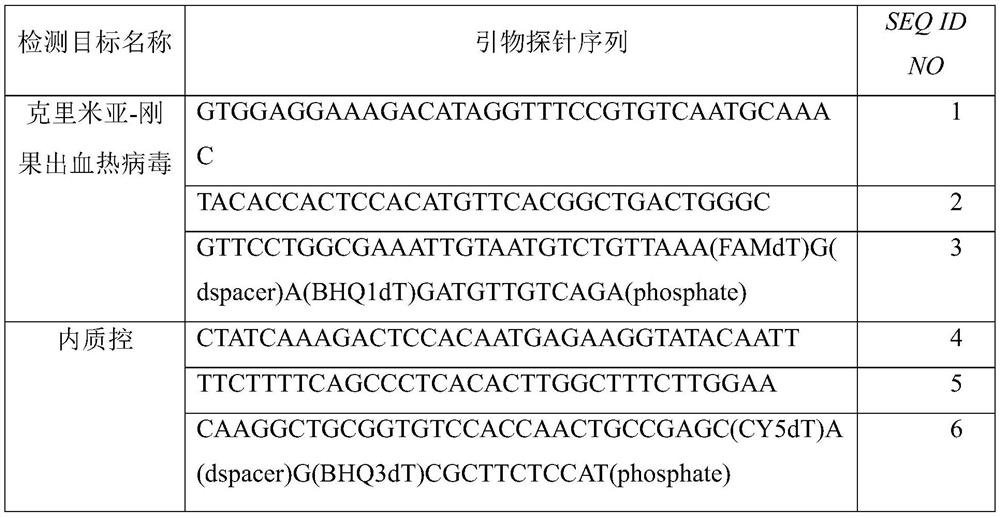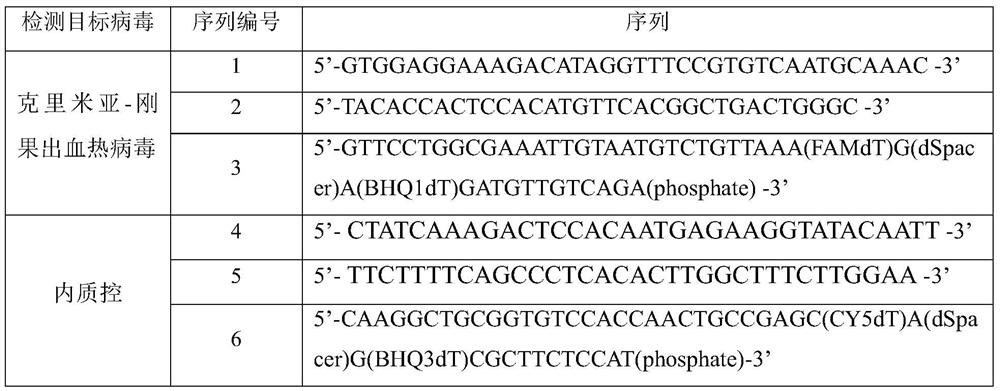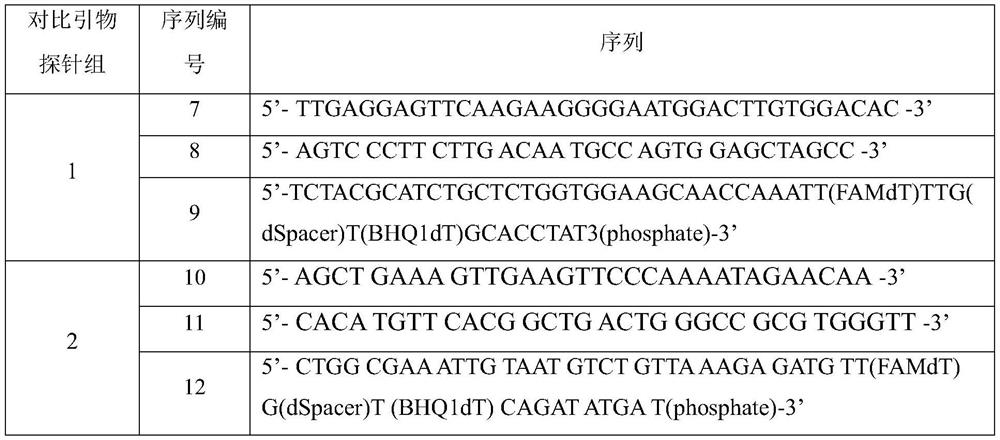Crimean-Congo hemorrhagic fever virus detection method and primer probe set
A Congo hemorrhagic fever, primer probe technology, applied in biochemical equipment and methods, recombinant DNA technology, microbial measurement/testing, etc., can solve the problems of Crimea-Congo hemorrhagic fever virus detection
- Summary
- Abstract
- Description
- Claims
- Application Information
AI Technical Summary
Problems solved by technology
Method used
Image
Examples
Embodiment 1
[0058] This example is used to illustrate the verification test of the Crimean-Congo hemorrhagic fever virus specific primer probe.
[0059] A reagent company was commissioned to synthesize the Crimean-Congo hemorrhagic fever virus primer probe set and internal quality control primer probe set shown in Table 2.
[0060] Table 2
[0061]
[0062] In the nucleotide sequence shown in SEQ ID NO.3, the 31st base from the 5' end is labeled with a FAM luminescent group, the 32nd base is connected with an abasic site, and the 34th base is marked with a quencher The killing group BHQ1, the 3' end is labeled with a phosphate group.
[0063] In the nucleotide sequence shown in SEQ ID NO.6, the 31st base from the 5' end is labeled with a CY5 luminescent group, the 32nd base is connected with an abasic site, and the 34th base is marked with a quencher The killing group BHQ3, the 3' end is labeled with a phosphate group.
Embodiment 2
[0087] Construction of primers, probes and kits for detection of Crimean-Congo hemorrhagic fever virus by recombinant enzyme polymerase amplification
[0088] The kit contains 2×RT-RPA buffer, lyophilized enzyme powder, 2 μL (10 μmol / L) of each primer, 0.5 μL (10 μmol / L) of probe, 1 μL (200 U / μL) of reverse transcriptase, positive control, ultra pure water.
[0089] The reaction system detected by the kit is 50 μL, which is prepared as follows: 25 μL of 2×RT-RPA buffer; lyophilized enzyme powder; 2 μL of each primer (10 μmol / L), 0.5 μL of probe (10 μmol / L); 1 μL of reverse transcriptase (200U / μL); template 5 μL, ultrapure water 15 μL.
Embodiment 3
[0091] Kit operation and result judgment
[0092] 1. Extraction of viral nucleic acid
[0093] In vitro transcribed RNA was extracted using commercially available extraction reagents.
[0094] 2. Preparation of reaction system
[0095] Take a 200 μL RPA tube to prepare a 50 μL reaction system, which is prepared as follows: 25 μL of 2×RT-RPA buffer; lyophilized enzyme powder; 2 μL of each primer (10 μmol / L), 0.5 μL of probe (10 μmol / L); reverse transcription Enzyme 1 μL (200U / μL); template 5 μL, ultrapure water 15 μL.
[0096] 3. RPA response
[0097] Put the RPA tube into the real-time fluorescence RPA instrument, select FAM and CY5 as the reporter group, and the RPA reaction program is as follows: 39°C for 10s, 39°C for 10s, 39°C for 10s (collecting fluorescence), 40 cycles.
[0098] 4. Result judgment
[0099]Blank control and negative and positive controls are established, otherwise the experimental results will be deemed invalid. If the sample has an amplification cu...
PUM
 Login to View More
Login to View More Abstract
Description
Claims
Application Information
 Login to View More
Login to View More - R&D
- Intellectual Property
- Life Sciences
- Materials
- Tech Scout
- Unparalleled Data Quality
- Higher Quality Content
- 60% Fewer Hallucinations
Browse by: Latest US Patents, China's latest patents, Technical Efficacy Thesaurus, Application Domain, Technology Topic, Popular Technical Reports.
© 2025 PatSnap. All rights reserved.Legal|Privacy policy|Modern Slavery Act Transparency Statement|Sitemap|About US| Contact US: help@patsnap.com



